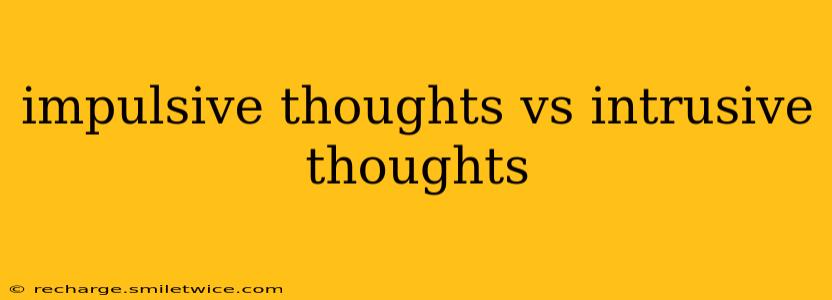Many people experience unwanted thoughts that pop into their minds unexpectedly. However, there's a crucial distinction between impulsive thoughts and intrusive thoughts, and understanding this difference is vital for managing these mental experiences. While both can be distressing, their nature and implications differ significantly. This article will explore the key characteristics of each, helping you better understand and address them.
What are Impulsive Thoughts?
Impulsive thoughts are urges or ideas that arise suddenly, often prompting immediate action. They're characterized by a strong feeling of needing to act on the thought right now. These thoughts aren't necessarily negative or harmful, but the impulsivity—the sudden, overwhelming urge to act—is the defining feature.
Examples of impulsive thoughts include:
- Sudden urge to shop: A strong, irresistible feeling to buy something, often without considering the need or financial implications.
- Sudden urge to eat: An overwhelming craving for a specific food, leading to immediate consumption regardless of hunger levels.
- Sudden urge to speak out: A strong impulse to say something without filtering or considering the consequences.
Key characteristics of impulsive thoughts:
- Sudden onset: They appear unexpectedly.
- Strong urge to act: There's a powerful drive to immediately act on the thought.
- Variable content: The thoughts themselves can range from harmless to potentially harmful.
- Linked to action: The defining feature is the immediate urge to act.
What are Intrusive Thoughts?
Intrusive thoughts, also known as unwanted thoughts, are unwelcome mental images, ideas, or impulses that repeatedly enter your mind. Unlike impulsive thoughts, they aren't necessarily accompanied by an immediate urge to act. Instead, they're often disturbing, anxiety-provoking, or even violent, causing significant distress. The individual doesn't want these thoughts, and often feels horrified or disgusted by them.
Examples of intrusive thoughts include:
- Fear of harming loved ones: Recurring thoughts about accidentally or intentionally hurting someone close to you.
- Fear of contamination: Persistent worries about germs or contamination, leading to excessive cleaning rituals.
- Sexual or violent images: Unwanted mental images of a sexual or violent nature that cause significant anxiety and distress.
Key characteristics of intrusive thoughts:
- Recurring and persistent: They frequently reappear.
- Unwanted and distressing: They cause significant emotional discomfort.
- Often negative or disturbing: The content is usually unpleasant or disturbing.
- May or may not lead to action: The urge to act is not the defining feature.
What is the difference between impulsive thoughts and intrusive thoughts?
The core difference lies in the urge to act. Impulsive thoughts are characterized by an immediate and strong compulsion to act, while intrusive thoughts are primarily marked by their unwanted and distressing nature, with the urge to act being secondary or absent. One is about the action, the other is about the thought itself.
Are impulsive thoughts a sign of a mental health condition?
Impulsivity can be a symptom of several mental health conditions, including ADHD, borderline personality disorder, and bipolar disorder. However, occasional impulsive thoughts are common and don't necessarily indicate a disorder. The severity, frequency, and impact on daily life are crucial factors in determining whether professional help is needed.
Are intrusive thoughts a sign of a mental health condition?
Intrusive thoughts are a common experience, particularly in anxiety disorders such as obsessive-compulsive disorder (OCD). However, experiencing intrusive thoughts doesn't automatically mean you have OCD. The key is the extent to which these thoughts interfere with your daily functioning and cause significant distress. If the thoughts are overwhelming and impacting your quality of life, professional help is advisable.
How can I manage impulsive and intrusive thoughts?
Managing both types of thoughts often involves a combination of strategies:
- Cognitive Behavioral Therapy (CBT): This therapeutic approach helps identify and challenge negative thought patterns and develop coping mechanisms.
- Mindfulness techniques: Practices like meditation can help increase awareness of thoughts without judgment, reducing their power.
- Lifestyle changes: Sufficient sleep, regular exercise, and a healthy diet can improve mental wellbeing.
- Medication: In some cases, medication can be helpful in managing underlying mental health conditions contributing to impulsive or intrusive thoughts.
It's essential to remember that seeking professional help is crucial if these thoughts significantly impact your daily life. A mental health professional can provide a proper diagnosis and develop a personalized treatment plan. Understanding the difference between impulsive and intrusive thoughts is the first step toward effective management.
